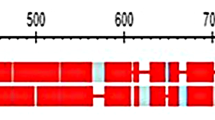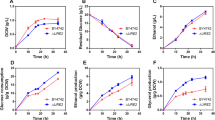Abstract
Cat8 is a C6 zinc cluster transcription activator in yeast. It is generally recognized that the transcription of CAT8 is inhibited and that Cat8 is inactive in the presence of high concentrations of glucose. However, our recent study found that constitutively overexpressed Cat8 played a regulatory role in Saccharomyces cerevisiae in the presence of 20 g/L glucose. To explore the regulatory network of Cat8 at high glucose concentrations, CAT8 was both overexpressed and deleted in this study. Cell growth and glucose consumption in different media were significantly accelerated by the deletion of CAT8, while the lag period was greatly shortened. RNA-seq and genetic modification showed that the deletion of CAT8 changed the type of energy metabolism in yeast cells. Many genes related to the mitochondrial respiratory chain were downregulated, resulting in a reduction in aerobic respiration and the tricarboxylic acid cycle. Meanwhile, both the energy supply of anaerobic ethanol fermentation and the Crabtree effect of S. cerevisiae were enhanced by the deletion of CAT8. CAT8 knockout cells show a higher sugar uptake rate, a higher cell growth rate, and higher tolerance to glucose than the wild-type strain YS58. This study expands the understanding of the regulatory network of Cat8 and provides guidance for modulating yeast cell growth.
Key points
• The deletion of CAT8 promoted cell growth of S. cerevisiae.
• Transcriptome analysis revealed the regulation network of Cat8 under 1% glucose condition.
• CAT8 deletion increases the glucose tolerance of cells by enhancing the Crabtree effect.






Similar content being viewed by others
Data availability
RNA sequencing data have been deposited at the National Microbiology Data Center (NMDC) with Accession Number NMDC10018227.
References
Albertyn J, Hohmann S, Thevelein JM, Prior BA (1994) GPD1, which encodes glycerol-3-phosphate dehydrogenase, is essential for growth under osmotic stress in Saccharomyces cerevisiae, and its expression is regulated by the high-osmolarity glycerol response pathway. Mol Cell Biol 14:4135–4144. https://doi.org/10.1128/mcb.14.6.4135-4144.1994
Anders S, Huber W (2010) Differential expression analysis for sequence count data. Genome Biol 11:R106. https://doi.org/10.1186/gb-2010-11-10-r106
Anders S, Pyl PT, Huber W (2015) HTSeq--a Python framework to work with high-throughput sequencing data. Bioinformatics 31:166–169. https://doi.org/10.1093/bioinformatics/btu638
Boles E, Hollenberg CP (1997) The molecular genetics of hexose transport in yeasts. FEMS Microbiol Rev 21:85–111. https://doi.org/10.1111/j.1574-6976.1997.tb00346.x
Bonander N, Ferndahl C, Mostad P, Wilks MD, Chang C, Showe L, Gustafsson L, Larsson C, Bill RM (2008) Transcriptome analysis of a respiratory Saccharomyces cerevisiae strain suggests the expression of its phenotype is glucose insensitive and predominantly controlled by Hap4, Cat8 and Mig1. BMC Genomics 9:365. https://doi.org/10.1111/j.1574-6976.1997.tb00346.x
Bourgarel D, Nguyen CC, Bolotin-Fukuhara M (1999) HAP4, the glucose-repressed regulated subunit of the HAP transcriptional complex involved in the fermentation-respiration shift, has a functional homologue in the respiratory yeast Kluyveromyces lactis. Mol Microbiol 31:1205–1215. https://doi.org/10.1046/j.1365-2958.1999.01263.x
Brons JF, De Jong M, Valens M, Grivell LA, Bolotin-Fukuhara M, Blom J (2002) Dissection of the promoter of the HAP4 gene in S. cerevisiae unveils a complex regulatory framework of transcriptional regulation. Yeast 19:923–932. https://doi.org/10.1002/yea.886
Buschlen S, Amillet JM, Guiard B, Fournier A, Marcireau C, Bolotin-Fukuhara M (2003) The S. cerevisiae HAP complex, a key regulator of mitochondrial function, coordinates nuclear and mitochondrial gene expression. Comp Funct Genomics 4:37–46. https://doi.org/10.1002/cfg.254
Buziol S, Warth L, Magario I, Freund A, Siemann-Herzberg M, Reuss M (2008) Dynamic response of the expression of hxt1, hxt5 and hxt7 transport proteins in Saccharomyces cerevisiae to perturbations in the extracellular glucose concentration. J Biotechnol 134:203–210. https://doi.org/10.1016/j.jbiotec.2008.02.002
Charbon G, Breunig KD, Wattiez R, Vandenhaute J, Noël-Georis I (2004) Key role of Ser562/661 in Snf1- dependent regulation of Cat8p in Saccharomyces cerevisiae and Kluyveromyces lactis. Mol Cell Biol 24(10):4083–4091. https://doi.org/10.1128/mcb.24.10.4083-4091.2004
Chen Y, Nielsen J (2019) Energy metabolism controls phenotypes by protein efficiency and allocation. Proc Natl Acad Sci U S A 116:17592–17597. https://doi.org/10.1073/pnas.1906569116
de Alteriis E, Cartenì F, Parascandola P, Serpa J, Mazzoleni S (2018) Revisiting the Crabtree/Warburg effect in a dynamic perspective: a fitness advantage against sugar-induced cell death. Cell Cycle 17:688–701. https://doi.org/10.1080/15384101.2018.1442622
De Deken RH (1966) The Crabtree effect: a regulatory system in yeast. J Gen Microbiol 44:149–156. https://doi.org/10.1099/00221287-44-2-149
De Winde JH, Grivell LA (1995) Regulation of mitochondrial biogenesis in Saccharomyces cerevisiae. Intricate interplay between general and specific transcription factors in the promoter of the QCR8 gene. Eur J Biochem 233:200–208. https://doi.org/10.1111/j.1432-1033.1995.200_1.x
Du Z, Deng H, Cheng Y, Zhai Z, Guo X, Wang Z, He X (2022) Cat8 response to nutritional changes and interaction with Ehrlich pathway related factors. Front Microbiol 13:898938. https://doi.org/10.3389/fmicb.2022.898938
Ferreira Júnior JR, Spírek M, Liu Z, Butow RA (2005) Interaction between Rtg2p and Mks1p in the regulation of the RTG pathway of Saccharomyces cerevisiae. Gene 354:2–8. https://doi.org/10.1016/j.gene.2005.03.048
Fontanesi F, ** C, Tzagoloff A, Barrientos A (2008) Transcriptional activators HAP/NF-Y rescue a cytochrome c oxidase defect in yeast and human cells. Hum Mol Genet 17:775–788. https://doi.org/10.1093/hmg/ddm349
Gonzalez R, Morales P (2022) Truth in wine yeast. Microb. Biotechnol 15:1339–1356
Harlow EAW, Lane DP (1988) Antibodies: a laboratory manual. Cold Spring Harbor Laboratory Press, New York. https://doi.org/10.1111/1751-7915.13848
Hedbacker K, Carlson M (2008) SNF1/AMPK pathways in yeast. Front Biosci 13:2408–2420. https://doi.org/10.2741/2854
Hedges D, Proft M, Entian KD (1995) CAT8, a new zinc cluster-encoding gene necessary for derepression of gluconeogenic enzymes in the yeast Saccharomyces cerevisiae. Mol Cell Biol 15:1915–1922. https://doi.org/10.1128/MCB.15.4.1915
Jansen MLA, Diderich JA, Mashego M, Hassane A, de Winde JH, Daran-Lapujade P, Pronk JT (2005) Prolonged selection in aerobic,glucose-limited chemostat cultures of Saccharomyces cerevisiae causes a partial loss of glycolytic capacity. Microbiology (Reading) 151:1657–1669. https://doi.org/10.1099/mic.0.27577-0
Kim HJ, Winge DR (2013) Emerging concepts in the flavinylation of succinate dehydrogenase. Biochim Biophys Acta 1827(5):627–636. https://doi.org/10.1016/j.bbabio.2013.01.012
Kruckeberg AL (1996) The hexose transporter family of Saccharomyces cerevisiae. Arch Microbiol 166:283–292. https://doi.org/10.1007/s002030050385
Laemmli UK (1970) Cleavage of structural proteins during the assembly of the head of bacteriophage T4. Nature 227:680–685. https://doi.org/10.1038/227680a0
Laera L, Guaragnella N, Ždralević M, Marzulli D, Liu Z, Giannattasio S (2016) The transcription factors ADR1 or CAT8 are required for RTG pathway activation and evasion from yeast acetic acid-induced programmed cell death in raffinose. Microb Cell 3:621–631. https://doi.org/10.15698/mic2016.12.549
Lu S, Zhou C, Guo X, Du Z, Cheng Y, Wang Z, He X (2022) Enhancing fluxes through the mevalonate pathway in Saccharomyces cerevisiae by engineering the HMGR and β-alanine metabolism. Microb Biotechnol 15:2292–2306. https://doi.org/10.1111/1751-7915.14072
Luyten K, Riou C, Blondin B (2002) The hexose transporters of Saccharomyces cerevisiae play different roles during enological fermentation. Yeast 19:713–726. https://doi.org/10.1002/yea.869
Malina C, Yu R, Björkeroth J, Kerkhoven EJ, Nielsen J (2021) Adaptations in metabolism and protein translation give rise to the Crabtree effect in yeast. Proc Natl Acad Sci U S A 118. https://doi.org/10.1073/pnas.2112836118
Mao Y, Chen C (2019) The Hap complex in yeasts: structure, assembly mode, and gene regulation. Front Microbiol 10:1645. https://doi.org/10.3389/fmicb.2019.01645
Martinez-Ortiz C, Carrillo-Garmendia A, Correa-Romero BF, Canizal-García M, González-Hernández JC, Regalado-Gonzalez C, Olivares-Marin IK, Madrigal-Perez LA (2019) SNF1 controls the glycolytic flux and mitochondrial respiration. Yeast 36:487–494. https://doi.org/10.1002/yea.3399
Nielsen J (2014) Synthetic biology for engineering acetyl coenzyme A metabolism in yeast. MBio 5:e02153. https://doi.org/10.1128/mBio.02153-14
Otterstedt K, Larsson C, Bill RM, Ståhlberg A, Boles E, Hohmann S, Gustafsson L (2004) Switching the mode of metabolism in the yeast Saccharomyces cerevisiae. EMBO Rep 5(5):532–537. https://doi.org/10.1038/sj.embor.7400132
Pertea M, Kim D, Pertea GM, Leek JT, Salzberg SL (2016) Transcript-level expression analysis of RNA-seq experiments with HISAT, StringTie and Ballgown. Nat Protoc 11:1650–1667. https://doi.org/10.1038/nprot.2016.095
Pfeiffer T, Morley A (2014) An evolutionary perspective on the Crabtree effect. Front Mol Biosci 1:17. https://doi.org/10.3389/fmolb.2014.00017
Rahner A, Schöler A, Martens E, Gollwitzer B, Schüller HJ (1996) Dual influence of the yeast Cat1p (Snf1p) protein kinase on carbon source-dependent transcriptional activation of gluconeogenic genes by the regulatory gene CAT8. Nucleic Acids Res 24:2331–2337. https://doi.org/10.1093/nar/24.12.2331
Randez-Gil F, Bojunga N, Proft M, Entian KD (1997) Glucose derepression of gluconeogenic enzymes in Saccharomyces cerevisiae correlates with phosphorylation of the gene activator Cat8p. Mol Cell Biol 17:2502–2510. https://doi.org/10.1128/MCB.17.5.2502
Reifenberger E, Boles E, Ciriacy M (1997) Kinetic characterization of individual hexose transporters of Saccharomyces cerevisiae and their relation to the triggering mechanisms of glucose repression. Eur J Biochem 245:324–333. https://doi.org/10.1111/j.1432-1033.1997.00324.x
Roth S, Kumme J, Schüller HJ (2004) Transcriptional activators Cat8 and Sip4 discriminate between sequence variants of the carbon source-responsive promoter element in the yeast Saccharomyces cerevisiae. Curr Genet 45:121–128. https://doi.org/10.1007/s00294-003-0476-2
Schüller HJ (2003) Transcriptional control of nonfermentative metabolism in the yeast Saccharomyces cerevisiae. Curr Genet 43:139–160. https://doi.org/10.1093/nar/24.23.4599
Sebollela A, Louzada PR, Sola-Penna M, Sarone-Williams V, Coelho-Sampaio T, Ferreira ST (2004) Inhibition of yeast glutathione reductase by trehalose: possible implications in yeast survival and recovery from stress. Int J Biochem Cell Biol 36:900–908. https://doi.org/10.1016/j.biocel.2003.10.006
Shen L, Huang M, Li X, Wu L, Tao Z, Chen S (2020) Knockout notch1 gene can enhanced radiosensitivity of nasopharyngeal carcinoma cells. Otolaryngol-Head N 34(1):64–69. https://doi.org/10.13201/j.issn.1001-1781.2020.01.016
Tachibana C, Yoo JY, Tagne JB, Kacherovsky N, Lee TI, Young ET (2005) Combined global localization analysis and transcriptome data identify genes that are directly coregulated by Adr1 and Cat8. Mol Cell Biol 25:2138–2146. https://doi.org/10.1128/MCB.25.6.2138-2146.2005
Towbin H, Staehelin T, Gordon J (1979) Electrophoretic transfer of proteins from polyacrylamide gels to nitrocellulose sheets: procedure and some applications. Proc Natl Acad Sci U S A 76:4350–4354. https://doi.org/10.1073/pnas.76.9.4350
Turcotte B, Liang XB, Robert F, Soontorngun N (2010) Transcriptional regulation of nonfermentable carbon utilization in budding yeast. FEMS Yeast Res 10:2–13. https://doi.org/10.1111/j.1567-1364.2009.00555.x
van Dijken JP, Weusthuis RA, Pronk JT (1993) Kinetics of growth and sugar consumption in yeasts. Antonie Van Leeuwenhoek 63:343–352. https://doi.org/10.1007/BF00871229
Vander Heiden MG, Cantley LC, Thompson CB (2009) Understanding the Warburg effect: the metabolic requirements of cell proliferation. Science 324:1029–1033. https://doi.org/10.1126/science.1160809
Vemuri GN, Altman E, Sangurdekar DP, Khodursky AB, Eiteman MA (2006) Overflow metabolism in Escherichia coli during steady-state growth: transcriptional regulation and effect of the redox ratio. Appl Environ Microbiol 72:3653–3661. https://doi.org/10.1128/AEM.72.5.3653-3661.2006
Wikström M, Sjöbring U, Drakenberg T, Forsén S, Björck L (1995) Map** of the immunoglobulin light chain-binding site of protein L. J Mol Biol 250:128–133. https://doi.org/10.1006/jmbi.1995.0364
Zaman S, Lippman SI, Zhao X, Broach JR (2008) How Saccharomyces responds to nutrients. Annu Rev Genet 42:27–81. https://doi.org/10.1146/annurev.genet.41.110306.130206
Zeng P, Lu W, Tian J, Qiao S, Li J, Glorieux C, Huang P (2022) Reductive TCA cycle catalyzed by wild-type IDH2 promotes acute myeloid leukemia and is a metabolic vulnerability for potential targeted therapy. J Hematol Oncol 15:30. https://doi.org/10.1186/s13045-022-01245-z
Zhou C, Li M, Lu S, Cheng Y, Guo X, He X, Wang Z, He XP (2021) Engineering of cis-element in Saccharomyces cerevisiae for efficient accumulation of value-added compound squalene via downregulation of the downstream metabolic flux. J Agric Food Chem 69:12474–12484. https://doi.org/10.1021/acs.jafc.1c04978
Acknowledgements
We thank our lab members for their technical support.
Author information
Authors and Affiliations
Contributions
HD designed the research, performed the experiments, analyzed the data, and wrote the manuscript. ZD and SL provided methodology, data analysis, and experimental assistance. ZW and XH supervised the overall progress and reviewed the manuscript. All authors read and approved the manuscript. HD and ZW comprehensively revised the paper.
Corresponding authors
Ethics declarations
Ethics approval
This article does not contain any studies with human participants or animals performed by any of the authors.
Conflict of interest
The authors declare no competing interests.
Additional information
Publisher’s note
Springer Nature remains neutral with regard to jurisdictional claims in published maps and institutional affiliations.
Supplementary information
ESM 1
(PDF 898 kb)
Rights and permissions
Springer Nature or its licensor (e.g. a society or other partner) holds exclusive rights to this article under a publishing agreement with the author(s) or other rightsholder(s); author self-archiving of the accepted manuscript version of this article is solely governed by the terms of such publishing agreement and applicable law.
About this article
Cite this article
Deng, H., Du, Z., Lu, S. et al. Regulation of Cat8 in energy metabolic balance and glucose tolerance in Saccharomyces cerevisiae. Appl Microbiol Biotechnol 107, 4605–4619 (2023). https://doi.org/10.1007/s00253-023-12593-2
Received:
Revised:
Accepted:
Published:
Issue Date:
DOI: https://doi.org/10.1007/s00253-023-12593-2




